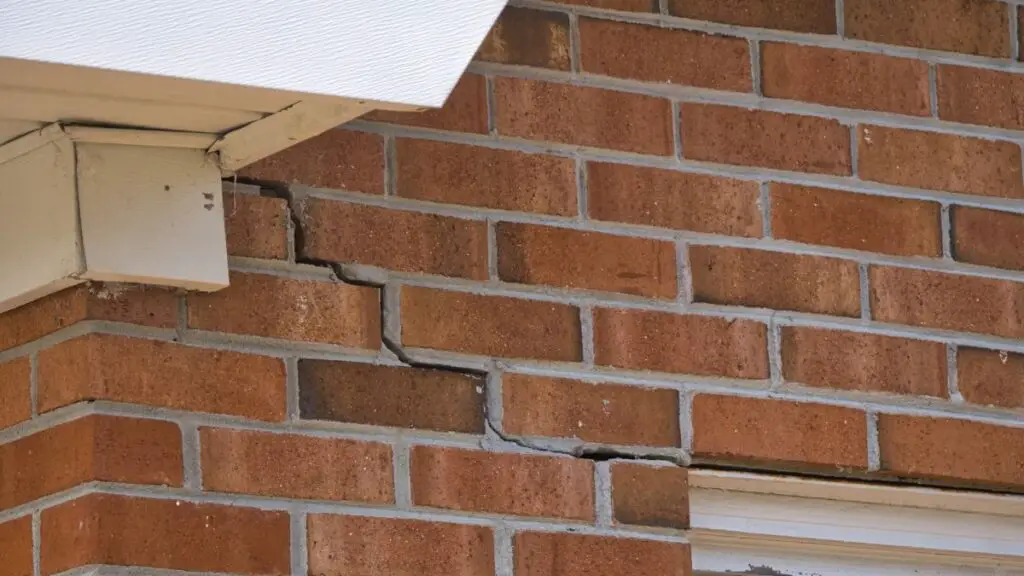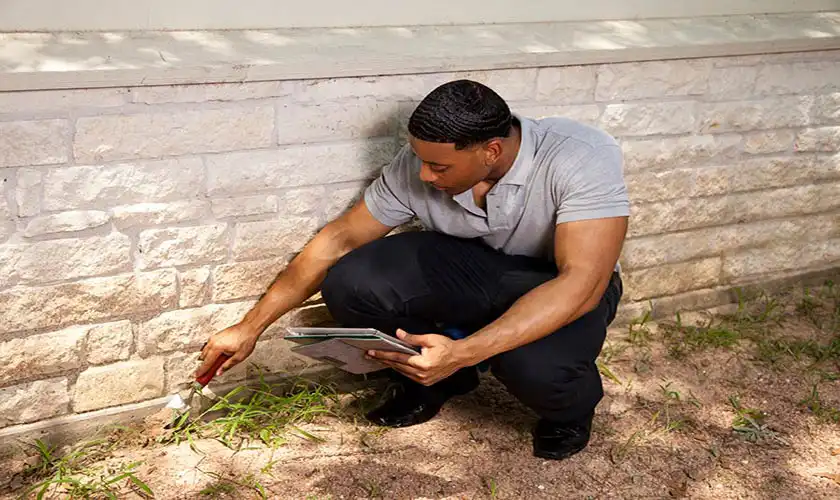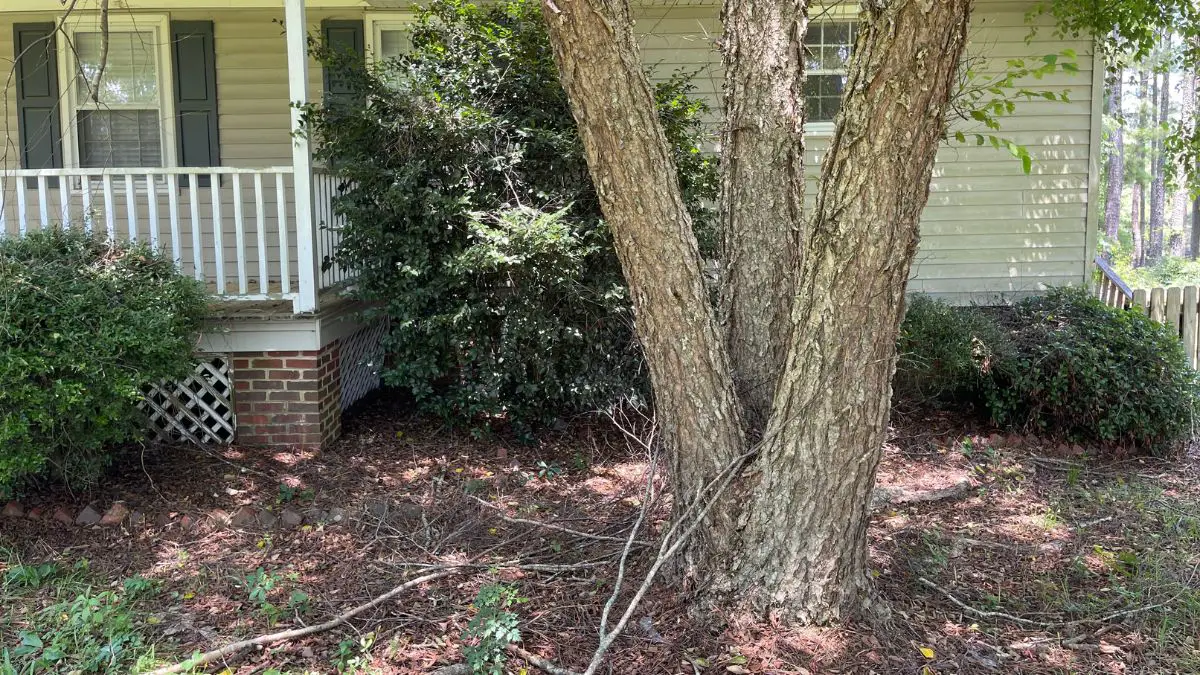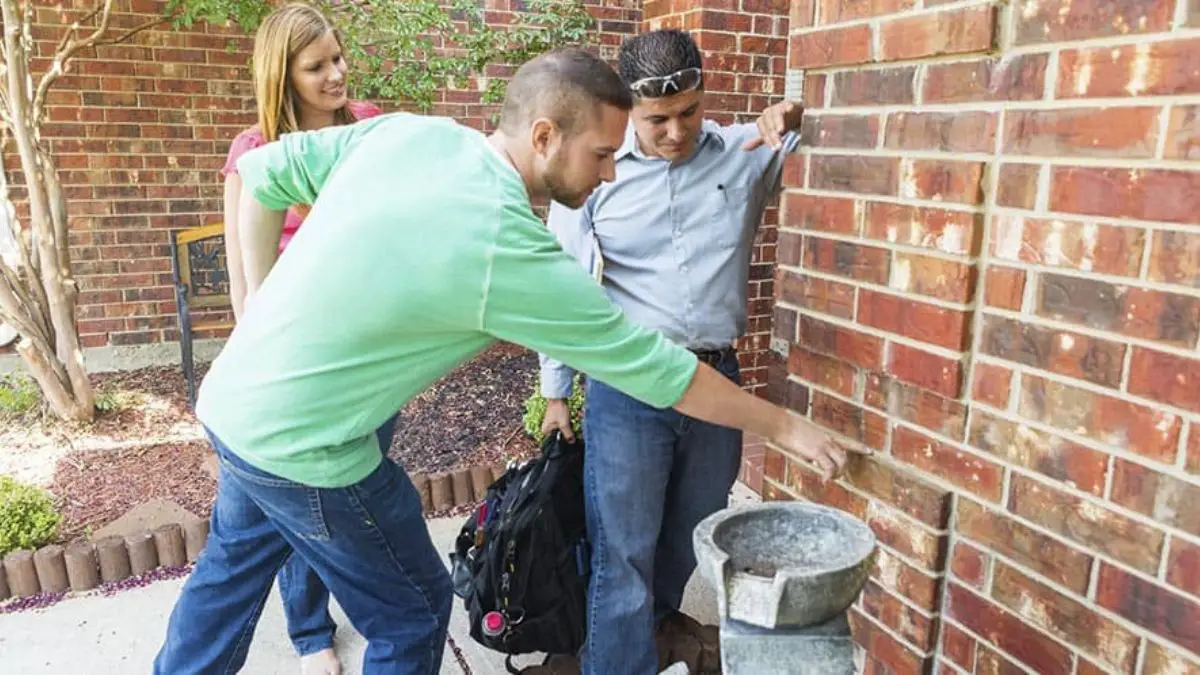Stair step cracks in your foundation can occur due to natural settling or could indicate a serious foundation problem. These cracks typically occur in masonry or concrete foundations due to factors such as foundation settlement. Diagonal or stepped fractures along the vertical or horizontal mortar joints characterize them.
Stair-step cracks occur in brick or block foundation walls due to foundation settlement, often resulting from shifting or unstable soil creating a void beneath the entire foundation walls, known as differential settlement.
Stair-step cracks are commonly associated with bowing walls in block foundations and basement walls. Diagonal or “step” cracking in concrete block walls and certain brick or CMU walls can be attributed to frost heave or settlement.
Get FREE quotes from local foundation repair contractors in your area today. Whether you need a pier replaced, basement waterproofing, or a full foundation replacement - We Can Help! All Contractors are screened, licensed, and insured.
| Key Takeaways |
|---|
| Stair-step cracks in the foundation are a common issue that homeowners should not ignore, as they indicate a structural problem that can lead to serious problems if left unaddressed. |
| Stair-step cracks appear as diagonal or stepped cracks along mortar joints in exterior brick walls, starting small but growing over time and causing a loss of structural integrity. |
| Repair methods for stair-step cracks include epoxy injection, installation of carbon fiber strips for reinforcement, and excavation for installing waterproofing membranes. |
| Causes of stair-step cracks include settlement and shifting of unstable soil, hydrostatic pressure, and poor construction practices. |
| Proper site preparation, high-quality materials, and regular maintenance are crucial for preventing and addressing foundation stair-step cracks. |
| Different types of stair-step cracks, such as vertical, horizontal, and diagonal cracks, may indicate different causes and levels of severity. |
| Signs and symptoms of stair-step cracks include visible cracks on walls, uneven floors or sloping walls, and doors and windows that stick or won’t close properly. |
| Different types of stair-step cracks, such as vertical, horizontal, and diagonal, may indicate different causes and levels of severity. |
| Prevention measures include proper site preparation before construction, using high-quality materials, and regular maintenance and inspections. |

Identifying and Addressing the Problem
Stair-step cracks in the foundation are a sign of potential foundation failure that homeowners should not ignore. They indicate a structural problem with the foundation of the building that can lead to serious problems if left unaddressed.
The cracks, resembling stair steps, appear diagonally or in a stepped pattern along bricks and mortar. While they may start small, these cracks tend to worsen over time, compromising the structural integrity of the building.
What Causes Foundation Cracks?
Here is a list of common factors that can cause cracks in foundations, which may require a foundation repair specialist:
- Soil movement and settlement: Changes in the soil beneath the foundation, such as shrinkage, expansion, or consolidation, can lead to cracks.
- Hydrostatic pressure: Excessive water accumulation in the soil surrounding the foundation can create pressure against the walls, resulting in cracks.
- Poor soil compaction: Insufficient compaction during the construction process can lead to differential settlement and the formation of cracks.
- Improper drainage: Inadequate or faulty drainage systems can cause water to pool around the foundation, leading to increased pressure and potential cracks.
- Freezing and thawing cycles: Repeated freeze-thaw cycles can exert pressure on the foundation and contribute to cracking in regions with cold climates.
- Poor construction foundation practices: Deficiencies in the construction process, such as inadequate reinforcement, improper concrete mix, or insufficient curing, can result in structural foundation cracks.
The specific causes of cracks can vary depending on the location, poor soil conditions, and construction practices. Consulting with a foundation repair specialist can help identify the exact factors contributing to foundation cracks in a specific scenario.
Definition of Stair-Step Cracks in Foundation
Stair-step cracks refer to diagonal or stepped fractures along brickwork or mortar joints. These types of cracks are commonly seen on masonry walls, particularly those made from concrete blocks or bricks, including those with a concrete foundation.
Various factors, including unbalanced soil settlement, poor construction practices, and hydrostatic pressure can cause stair-step fractures. It is important to note that not all stair-step fractures are cause for concern; however, it is recommended that homeowners have them inspected by a professional to make sure they do not indicate any serious issues.
The Importance of Identifying and Addressing Stair-Step Cracks
Identifying and addressing stair-step cracks in foundations is crucial for several reasons. First and foremost, these types of fractures can weaken the structural integrity of your home’s foundation over time. This can lead to further damage, such as uneven floors or sloping walls, that could ultimately compromise the safety of your home.
Additionally, ignoring these types of fractures can lead to water intrusion into your home, which can cause mold growth and other types of water damage that can be costly and difficult to repair. Identifying these types of fractures early on will make repairs easier and less expensive than waiting until they become major problems.
You should know and understand the potential dangers of stair-step cracks in foundations. By identifying and addressing these fractures early on, you can prevent further damage to your home’s foundation and protect your investment for years.
Are Step Cracks Bad?
Step cracks are generally an indication of a more serious underlying problem and can indicate structural damage or instability in the foundation of a home. As such, they should not be ignored. It is best to consult a professional to assess the cause of the step cracks and recommend an appropriate solution to fix the problem.
Causes of Stair-Step Cracks in Foundation
Stair-step cracks in foundations occur due to different reasons. The following are some of the most common causes that can lead to stair-step cracks in foundations.
Settlement and Shifting of Soil
One of the most common causes of stair-step cracks in foundations is settlement and shifting of soil. The soil beneath a building’s foundation can settle or shift, creating gaps that cause the foundation to move. Foundation movement can lead to stair-step cracks forming on exterior or interior walls.
Shifting soil can cause problems in concrete slabs and basement foundations. Helical piers along the exterior concrete foundation walls can help move the masonry walls back into place, stabilizing the foundation, and closing cracks.
Several factors can cause soil settlement, including improper site preparation, poor drainage, changes in the water table, and natural erosion over time. This issue becomes more severe in areas with expansive soils, where clay-rich soils shrink and swell with moisture changes.
When a building is constructed on soil that has not been properly compacted or prepared for construction, it may be vulnerable to settling and shifting over time. Preventing this from happening during construction requires proper site preparation by compacting soil or removing unstable ground.
According to North Dakota State University (NDSU), dry soil due to droughts can also contribute to foundation problems. “Sticking doors or windows and cracks in walls may be indications that the building is shifting due to soil shrinkage,” says Ken Hellevang, North Dakota State University Extension agricultural engineer.
Hydrostatic Pressure
Hydrostatic pressure is another common cause of stair-step cracks in the foundation. This occurs when water builds up around the perimeter of a home’s foundation due to poor drainage or grading.
As water accumulates around the foundation, it exerts pressure against it and results in cracking. The pressure exerted by hydrostatic force is considerable – up to 62 pounds per cubic foot – so even small amounts of water buildup along the perimeter can result in significant damage over time.
Proper drainage systems like gutters and downspouts should be installed to direct rainwater away from the base of your home. Drainage tiles can be installed under your slab to protect against hydrostatic pressure.
Poor Construction Practices
Poor construction practices, such as using low-quality materials, improper footing depth, and inadequate reinforcement, can also lead to stair-step cracks in the foundation. These factors can weaken the foundation and make it more prone to cracking.
Choosing high-quality materials for construction and using appropriate reinforcement techniques – such as steel rebar or mesh – during concrete pours can help prevent stair-step cracks from forming.
Proper footing depth is also crucial for supporting the structure’s weight and maintaining the soil around it. Understanding the causes of stair-step cracks in foundations is critical to identifying and addressing them effectively.
Taking preventative measures during construction or conducting regular maintenance on existing structures can minimize the risk of damage due to soil settlement or hydrostatic pressure.
If you find yourself with a cracked foundation due to poor construction practices or other issues, consult a professional who specializes in repairing these types of problems immediately.
For more in-depth information, you can check the following related article: Common Problems with Cinder Block Foundations

Types of Stair-Step Cracks in Foundation
Stair-step, vertical, horizontal, diagonal, or foundation wall cracks are not created equally. Each type of crack may indicate different causes and levels of severity in the foundation wall. Identifying the specific crack type is crucial to understanding the underlying issue and determining the appropriate repair method.
Vertical Foundation Cracks
Vertical cracks run straight up and down with no angle deviation. These cracks often occur at the corners of buildings or windows and doors.
They can be caused by natural soil settlement, water damage, or poor construction practices. Vertical cracks usually do not pose a significant structural threat unless over 1/4 inch wide.
However, if left unchecked, even small vertical cracks can become bigger over time due to continuous expansion and contraction from temperature changes. As such, it is best practice to seal vertical cracks with an epoxy injection before they become wider or deeper.
Horizontal Foundation Cracks
Unlike vertical cracks that go up and down, horizontal cracks, indicative of a foundation issue, run parallel to the ground level. They are usually the result of hydrostatic pressure from water buildup in the soil surrounding your foundation.
Water accumulation puts pressure on your foundation walls, which can cause them to bow inwardly or outwardly, resulting in horizontal cracks. These types of stair-step cracking should be taken seriously as they indicate that your home’s foundation is under great stress.
When you notice horizontal cracking around your home’s footings, consulting an expert for evaluation is necessary. In extreme cases, excavation work may need to be done around the perimeter of your house, followed by waterproofing installation to prevent further damage.
Diagonal Foundation Cracks
Diagonal crack patterns indicate that there may be some structural movement going on beneath your home’s foundation walls. Diagonal crack patterns that rise from one side towards another at an angle greater than 30 degrees may point to a more serious situation.
Foundation walls may be moving in different directions, leading to structural damage if not addressed.
The cause of these types of cracks often involves shifts in soil and foundation settling and can be related to poor construction practices. Identifying the type and location of stair-step cracks in your foundation is crucial.
It can lead to a better understanding of the underlying causes and help you make informed repair decisions. Consulting with an expert for evaluation is always recommended, as it will ensure the issue is properly diagnosed before any repair work is undertaken.
Summary
Vertical cracks are usually harmless unless over 1/4 inch wide, while horizontal cracks indicate foundation stress and may require excavation and waterproofing. Diagonal cracks suggest structural movement and should be evaluated by an expert for proper diagnosis and repair.
Signs and Symptoms of Stair-Step Cracks in Foundation
Stair-step cracks in the foundation are a serious issue that should never be ignored. Identifying these cracks early on is crucial since the longer you wait to deal with them, the more extensive and expensive repairs can become. The most common signs and symptoms of stair-step cracks in the foundation include:
Visible Cracks on Exterior or Interior Walls
The first obvious sign of stair-step cracks is the appearance of visible cracks on exterior or interior walls. These may appear as horizontal, vertical or diagonal lines that extend up and down a wall.
If these lines widen over time, something shifts or settles underneath the foundation. These visible cracks can also signify other structural issues like drainage problems, soil erosion, or poor construction practices.
Uneven Floors or Sloping Walls
If your floors are sloping downwards towards one corner of the room, it’s likely that your foundation has shifted and caused an uneven distribution of weight across the flooring.
Uneven floors can also cause doors and windows to become out of alignment, making them difficult to open or close properly. Additionally, you may notice that furniture, such as tables and chairs, wobble because they cannot sit level on slanted floors.
Doors and Windows That Stick or Won’t Close Properly
If you’re having difficulty opening and closing doors and windows smoothly, this could be due to stair-step crack issues in your foundation.
That’s because these types of cracks can cause shifts in door frames which lead to sticking doors, warped jambs or sagging lintels above window openings. When this occurs, it makes your house vulnerable to drafts, increasing heating bills during winter months.
If you notice any signs of stair-step cracks in your foundation, calling a professional is the best way to ensure the issue is dealt with promptly and effectively. Don’t let these issues go unchecked, as they can lead to more extensive and costly repairs.
Summary
Visible cracks on walls, uneven floors or sloping walls, and doors/windows that stick or won’t close properly are indicators of foundation issues that should be addressed promptly to prevent further damage and costly repairs.
Repairing Stair-Step Cracks in Foundation
There are three primary ways to repair stair-step cracks in foundations. These include the following:
Filling the Crack with Epoxy Injection
Epoxy crack injections are an effective method of repairing stair-step cracks in the foundation and concrete slabs. This process involves injecting epoxy material into the crack, which hardens and forms a bond with the surrounding concrete, effectively sealing the crack.
The epoxy used for this purpose is specially formulated to withstand the foundation’s and concrete slabs’ natural movement over time.
Installing Carbon Fiber Strips to Reinforce the Wall
Carbon fiber strips are an effective solution for reinforcing walls that have experienced structural damage due to stair-step cracks. These strips are made of a high-strength carbon fiber material that provides excellent tensile strength and flexibility.
They can be applied directly to the wall using a specially formulated adhesive, which ensures a strong bond between the carbon fiber strip and the wall.
Excavating Around the Foundation to Install Waterproofing Membrane
If stair-step cracks in your foundation, caused by water damage or foundation movement, are present, excavation may be necessary to install a waterproofing membrane around your home’s foundation.
Digging down around your foundation and applying a waterproof barrier material such as hydrophilic or hydrophobic coatings or membranes helps to seal the foundation from the outside, providing years of waterproofing for your foundation.
Summary
Repair options include epoxy injection to seal the crack, carbon fiber strips for reinforcement, and excavation to install a waterproofing membrane for long-term protection against water damage.
Prevention of Stair-Step Cracks in Foundation
You can take four key steps to prevent stair-step cracking in your foundation. By following these measures, you can safeguard your home against potential damage and maintain its structural integrity:
Proper Site Preparation Before Construction Begins
One of the crucial factors in preventing stair-step cracks is ensuring proper site preparation before construction begins. Take charge and ensure that the soil is stable and compacted to provide a solid base for your foundation.
Additionally, it is essential to grade the site effectively, ensuring that water doesn’t accumulate near your home’s foundation. By taking these measures, you will lay the foundation for a strong and crack-resistant structure.
Moisture Control Around Your Home
Moisture control plays a significant role in preventing stair-step cracks. To fortify your foundation against such cracks, it is crucial to implement effective moisture control measures.
Keep a close eye on the areas around your home and take immediate action to divert water away from the foundation. Ensure your gutters are properly installed and functioning optimally to channel water away from your home.
Maintaining moisture levels around your home can eliminate a common cause of foundation cracks.
Using High-Quality Materials During Construction
The quality of materials used during construction directly impacts the strength and durability of your foundation. To prevent stair-step cracks, use high-quality materials throughout the construction process. When pouring concrete, reinforce it with steel bars (rebar) to enhance its structural integrity.
Choose high-quality cement and aggregate materials resistant to moisture and other environmental factors. By investing in quality materials, you’re investing in the long-term health of your foundation.
Regular Maintenance and Inspections
Being proactive through regular maintenance and inspections is crucial in preventing potential issues from escalating into major problems. Take charge of your home’s foundation by inspecting it regularly for any signs of cracks or damage.
If you notice any issues, address them promptly to prevent further deterioration. Additionally, ensure that your gutters are in good condition and effectively divert water away from the foundation. By staying vigilant and proactive, you can catch and address any concerns before they become significant challenges.
Summary
Preventing stair-step cracks in your foundation requires proper site preparation, effective moisture control around your home, and the use of high-quality materials during construction. Additionally, regular maintenance and inspections are crucial to identify and address any potential issues before they escalate.
Stair Step Cracks in Foundation FAQs
If your foundation has stair-step cracking, you will have some questions. Here are the most commonly asked questions we hear from homeowners.
Can stair-step cracks be fixed?
Stair-step cracks in foundations can be repaired using methods like epoxy injection, crack stitching, underpinning, and waterproofing. A professional assessment is advised to determine the best approach based on severity and cause.
What causes stair-step cracks?
Soil settlement, hydrostatic pressure, poor construction practices, frost heave, or moisture problems can cause foundation to stair-step cracks. Consulting with a professional is important for accurate diagnosis and appropriate repairs.
How do you know if a foundation crack is serious?
Consider its width, movement, and associated structural issues to determine if a foundation crack is serious. Consult a professional for evaluation.
What foundation floor cracks should I be concerned about?
Foundation floor cracks that are spreading, displaced, or accompanied by other signs of structural issues, such as uneven floors or sloping walls, are concerning. You should have a foundation specialist look for underlying causes and offer repair options.
Conclusion
Early detection and repair of stair-step cracks in your foundation caused by factors like foundation settlement, tree roots, or concrete shrinkage are crucial to prevent further damage.
Proper site preparation, high-quality construction materials, and regular maintenance, including techniques such as helical piers, can minimize the risk of these cracks in your foundation.
Stair-step cracks in your foundation may indicate underlying foundation movement. Effective foundation crack repair methods such as epoxy injection and carbon fiber strips can reinforce the wall. Don’t wait until it is too late!








